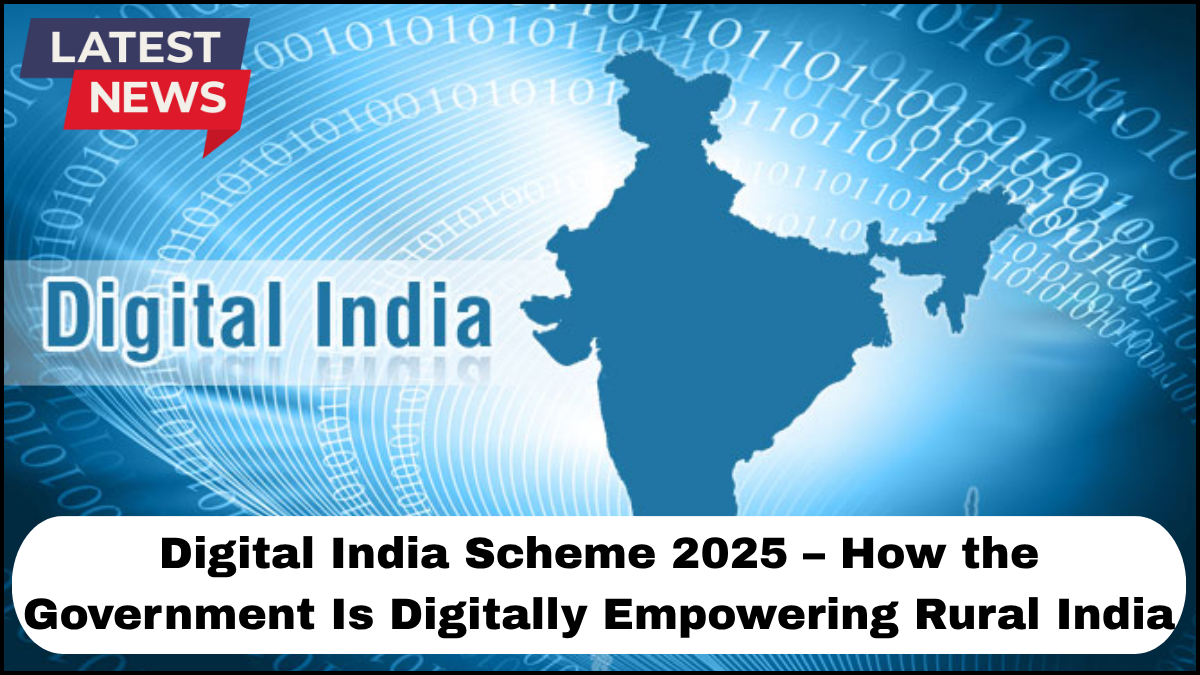The Digital India Scheme has evolved into a far-reaching platform by 2025, aiming to bring seamless digital access and services to every corner of India—especially rural areas. While the initial initiative launched in 2015 focused on connectivity, digital infrastructure, and government services, the 2025 phase emphasizes a strategic Rural Digitization Push that targets grassroots growth, inclusion, and sustainability.

H3: Infrastructure Expansion and High-Speed Connectivity
A core pillar of the 2025 digital strategy is expanding broadband connectivity across villages. The government has accelerated deployment of optical fiber under BharatNet, now reaching more than 99% of gram panchayats. With high-speed internet available even in remote hamlets, villagers can access government portals, education platforms, telehealth services, and e-commerce marketplaces.
To bridge the last-mile gap, the Digital India Scheme 2025 supports solar-powered mobile towers and community Wi‑Fi centres. These decentralized hubs allow local access without needing personal smartphones or costly data plans—making it a key driver of digital inclusion.
H3: Digital Literacy and Grassroots Training
Connectivity alone isn’t enough—digital literacy is vital. As part of the Rural Digitization Push, multiple thousand digital training centres have been set up in schools, panchayat offices, and community halls. These centres provide hands-on workshops on smartphone usage, digital payments, government portals (e.g., e‑Sanchar, e-Shram), and cybersecurity basics.
By 2025, the government’s initiative “Digital Saksharta Saksham (DSS)” has certified over five million rural citizens in basic digital competencies. Trainers are often local youth who understand regional language and culture, enhancing adoption rates significantly.
H3: e‑Governance and Seamless Access to Services
A pivotal aspect of the Digital India Scheme is making government services accessible digitally. Rural residents can now apply for farming subsidies, ration cards, pensions, education scholarships, and health insurance entirely online—reducing reliance on physical offices.
Integration with Common Service Centres (CSCs) transforms panchayat offices into one-stop digital hubs. Local entrepreneurs, often trained under the CSC model, assist residents in filing digital requests and tracking status in real time. Fee waivers or nominal charges make these services affordable.
H3: Digital Payments and Financial Inclusion
Financial inclusion drives economic empowerment. The Digital India Scheme 2025 accelerates adoption of digital payments in villages via UPI, e-wallets, Aadhaar‑enabled payment systems (AePS), and micro‑ATM networks.
Point-of-sale (PoS) devices are widely installed at rural shops and markets. Microfinance institutions and self-help groups are encouraged to collect repayments digitally. This push minimizes cash handling risks and improves transparency in local transactions.
H3: Telehealth and Digital Healthcare Access
Telemedicine is an important focus of the Rural Digitization Push. Digital India’s telehealth platform connects rural clinics (often at primary health centres) to doctors in urban hospitals. Through video consultations, rural citizens can receive diagnostics, prescriptions, and referrals without traveling long distances.
Mobile medical vans equipped with diagnostic tools and portable devices upload health data to cloud‑based systems, enabling remote monitoring and preventive care. During the 2025 vaccination drives, real-time digital tracking ensured that every eligible citizen was covered effectively.
H3: Smart Agriculture Solutions
Agricultural livelihoods benefit from digital tools under the scheme. The initiative includes mobile apps and SMS-based services providing weather forecasts, crop advisories, soil health analyses, and market price updates.
Farmers can register their produce on digital mandis and access real‑time bidding—enhancing bargaining power and income. Additionally, drone‑based surveys and IoT sensors support precision agriculture, water management, and yield optimization.
H3: Digital Entrepreneurship and Rural Startups
In tandem with the Rural Digitization Push, the Digital India Scheme encourages rural entrepreneurship. Training modules empower local artisans, small business owners, and agricultural startups to market products via online platforms, social media, and direct-to-consumer e‑commerce.
CSCs double as incubation hubs, offering mentorship, micro loans facilitation, and digital marketing training. This nurtures local talent while creating employment opportunities in emerging rural digital economies.
H3: Data Security and Privacy Safeguards
A comprehensive approach accompanies the digital rollout—incorporating strong measures for data protection. Aadhaar-based authentication, end-to-end encrypted communication channels, and secure payment gateways are enforced across services.
The government organizes cybersecurity awareness campaigns in villages, highlighting phishing, fraud prevention, and safe online behaviour—ensuring citizens’ confidence in digital systems.
H3: Impact Highlights and Success Stories
-
Over 10 million rural users now file government applications online, a massive leap from previous years when in-person visits were mandatory.
-
Villages such as Chitradurga (Karnataka) and Saurashtra (Gujarat) act as pilot success zones—reporting increased agricultural income, widespread digital literacy, and higher participation in e-commerce.
-
Women-led self-help groups in Uttar Pradesh have adopted digital payment methods, boosting transparency in microloans and empowering financial autonomy at the grassroots.
Frequently Asked Questions (FAQ)
Q: What differentiates the 2025 phase from earlier rounds of the Digital India Scheme?
A: While earlier phases focused on connectivity and service portals, the 2025 iteration prioritizes a Rural Digitization Push with emphasis on digital literacy training, telehealth, smart agriculture support, and rural entrepreneurship—ensuring infrastructure and usage grow in parallel.
Q: How does the scheme ensure rural citizens are digitally literate?
A: Through hundreds of local digital training centres under programs like “Digital Saksharta Saksham,” often led by trained youth facilitators who teach in local languages and use interactive, practical modules.
Q: Are online government services free for rural inhabitants?
A: Many services accessed through CSCs or government portals are either free or available for nominal fees. Subsidized access helps reduce financial barriers and increase digital uptake.
Q: What benefits have farmers seen from digital agriculture tools?
A: Farmers gain access to weather alerts, crop advisory, soil health reports, digital mandi price discovery, and direct market linkages—resulting in higher yields, better pricing, and reduced dependency on middlemen.
Q: How does the government protect rural citizens from data breaches and fraud?
A: The scheme enforces secure Aadhaar authentication, encrypted payment systems, and rural cybersecurity education—empowering citizens to identify and avoid phishing and fraud attempts safely.
click here to learn more
